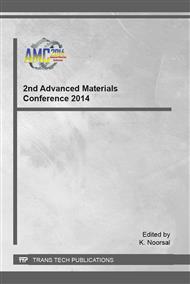p.547
p.552
p.557
p.561
p.566
p.571
p.579
p.583
p.588
Synthesis of Ionic Liquid Polymer Incorporating Activated Carbon for Carbon Dioxide Capture and Separation
Abstract:
CO2 capture and separation by ionic liquid is one of the fastest growing branches in ionic liquid technology. The aim of this research was to synthesize the ionic liquid polymer incorporating activated carbon and investigating its performance for CO2 capture and separation. The ionic liquid monomers 1-vinyl-3-ethylimidazolium bromide, [veim][Br] and 1-vinyl-3-ethylimidazolium bis (trifluoromethyl-sulfonyl) imide, [veim][Tf2N] were first synthesized and then polymerized into ionic liquid polymers incorporating activated carbon. The purity of the [veim][Br] and [veim][Tf2N] was verified by 1H NMR, 13C NMR and Ion Chromatography. Both monomers were proved to be in high purity. The elemental composition of both polymer materials synthesized were examined using energy dispersive X-ray spectroscopy (EDX) and the morphology of the synthesized material was observed using field emission scanning electron microscopy (FESEM). The results revealed that activated carbon has been successfully incorporated into the lattice structure of polymer materials. The fabricated polymer materials would be expected to have higher CO2 capture capability as it combines both the absorption and adsorption mechanism for CO2 apprehension and sequestration.
Info:
Periodical:
Pages:
566-570
Citation:
Online since:
January 2016
Keywords:
Price:
Сopyright:
© 2016 Trans Tech Publications Ltd. All Rights Reserved
Share:
Citation:


